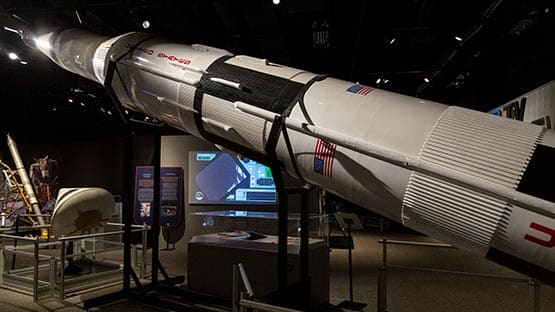
NASA’s historic Artemis I mission is coming to an end as the unmanned space capsule is returning to Earth but it marks the beginning of a possible return of astronauts to the moon. The capsule had 16 cameras on board to document the trip.
While Artemis I’s journey is coming to an end, the Virginia Museum of History & Culture in Richmond is counting down to the launch of an exciting new exhibition to explore the story behind the first missions to the moon, and Virginia’s role in getting us there.
The “Apollo: When We Went to the Moon” exhibit, opening in March, will chronicle how space exploration that began as an extension of the Cold War between U.S. and the Soviet Union ultimately led to international cooperation both on and off Earth.
The 7,000-square-foot exhibition organized by the U.S Space & Rocket Center will immerse visitors in the story of manned space flight through the eyes of the astronauts, but also through the experiences of the 400,000 scientists, engineers and contractors who made landings on the moon possible 50 years ago.
The exhibition features many artifacts from the U.S. Space & Rocket Center’s collections as well as powerful media presentations that capture both the excitement and turbulent nature of this pivotal era in our history.
Visitors can touch a piece of the Moon, be transported to the Apollo 11 launch pad as part of an immersive audiovisual experience; leave their “footprints” behind as they walk across a virtual lunar surface; and climb aboard a full-scale Apollo 17 lunar rover model to experience how astronauts got around on the moon.
“When Neil Armstrong stepped onto the lunar surface it was the culmination of decades of scientific advancement – much of which was occurred in Virginia. To this day, that remarkable accomplishment serves as an inspirational example of our ability to overcome countless challenges in pursuit of a common goal,” said Andrew Talkov, senior director of curatorial affairs at Virginia Museum of History & Culture. “As home to NASA’s Langley Research Center and Wallops Flight Facility, Virginia was – and continues to be -central to the success of our manned space programs.
Among those who worked on Project Mercury and other related projects were Virginians Katherine Johnson, Mary Jackson, Dorothy Vaughn and the West Computers.
These African American female mathematicians and extraordinary STEM trailblazers were featured in the best-selling 2016 book “Hidden Figures: The Story of the African American Women Who Helped Win the Space Race” by Margot Lee Shetterly, which became an award-winning movie in 2017.
The plans used to land on the moon were developed in Virginia.
Spacecrafts were meticulously designed and tested by Langley engineers, and in first-of-their-kind simulators, astronauts learned to join two small vehicles in the vastness of space, land on the lunar surface and return safely to Earth.
So successful was the work done here, that when asked what it was like to walk on the moon, Neil Armstrong simply replied: “Like Langley.”
The Virginia Museum of History & Culture is located at 428 N Arthur Ashe Boulevard in Richmond’s Museum District.
The exhibit will run from March 18 through Dec. 31, 2023.
For more information, visit virginiahistory.org










